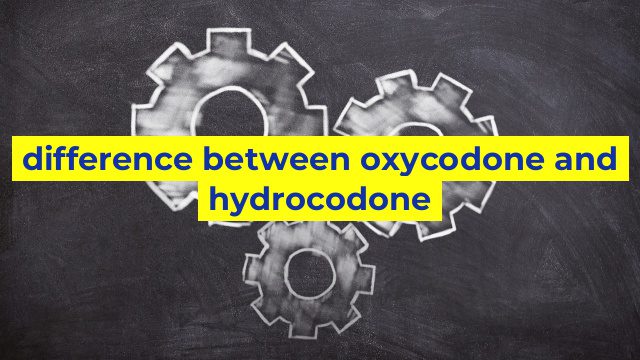Understanding the Difference Between Oxycodone and Hydrocodone
If you’re suffering from chronic pain, your doctor may prescribe you a medication to help alleviate your symptoms. Two medications that are commonly prescribed for pain relief are oxycodone and hydrocodone. Although these drugs are similar, they have some key differences that are important to know before taking them.
What is Oxycodone?
Oxycodone is a powerful painkiller that’s used to treat moderate to severe pain. It belongs to a class of drugs called opioids, which work by attaching to certain receptors in your brain and spinal cord to decrease your perception of pain. Oxycodone is available in both immediate-release and extended-release forms, and it’s commonly marketed under the brand names OxyContin and Percocet.
What is Hydrocodone?
Hydrocodone is another opioid medication that’s used to treat moderate to severe pain. Like oxycodone, it works by binding to opioid receptors in the brain and spinal cord to reduce pain signals. Hydrocodone is available in several forms, including immediate-release tablets and capsules, as well as extended-release formulations. It’s often sold under the brand names Vicodin and Norco.
The Key Differences Between Oxycodone and Hydrocodone
Although oxycodone and hydrocodone are both opioids that work in similar ways, there are some key differences between them. These differences include:
- Potency: Oxycodone is generally considered to be more potent than hydrocodone. This means that a smaller dose of oxycodone is needed to achieve pain relief than a dose of hydrocodone.
- Duration of Action: Oxycodone has a shorter half-life than hydrocodone, meaning that it doesn’t stay in the body as long. This can be a good thing for patients who need rapid pain relief, but it may also mean that they need to take the medication more frequently.
- Side Effects: Because oxycodone is more potent than hydrocodone, it may also carry a higher risk of side effects. However, both medications can cause similar side effects, including dizziness, nausea, constipation, and drowsiness.
Which Medication is Right for You?
The decision to use either oxycodone or hydrocodone will depend on the severity of your pain, as well as your individual medical history and other risk factors. Your doctor may also consider other factors, such as the potential for drug interactions and the risk of addiction, before making a recommendation.
Ultimately, it’s important to remember that both oxycodone and hydrocodone are potent prescription medications that should only be taken under the care of a qualified healthcare provider. If you’re experiencing pain, talk to your doctor about your treatment options and the potential benefits and risks of each medication.
Table difference between oxycodone and hydrocodone
| Oxycodone | Hydrocodone | |
|---|---|---|
| Classification | Schedule II | Schedule II |
| Brand Names | OxyContin, Roxicodone | Vicodin, Norco, Lortab, Hysingla ER |
| Pain Relief | Stronger | Less potent |
| Duration | Shorter duration | Longer duration |
| Abuse Potential | Higher | Lower |
| Side Effects | Nausea, vomiting, constipation, dry mouth, dizziness | Same as Oxycodone, plus drowsiness |
